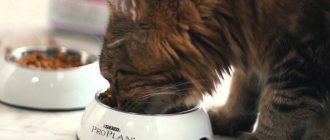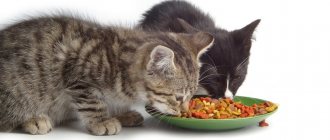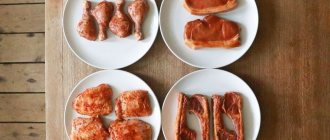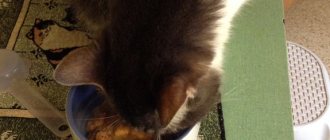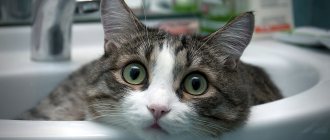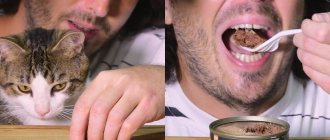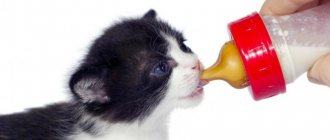Domestic cats are one of the most common companion animals. By type of nutrition, the cat is a strict (obligate) predator. This means that the cat prefers to eat prey that it has killed itself. We offer you general recommendations for feeding cats. A cat's needs will depend on its breed, size, age, energy level and health problems. Consult your veterinarian about how many calories your cat should consume each day and how to structure her diet.
- Cat nutrition features
- How a cat feeds kittens
- What to feed a cat: what natural products can be given to a cat
- Is it possible to give a cat fish, pork, milk, raw liver, bones, smoked meats?
- What other foods should you not give to your cat?
- How and how much to feed a cat
- How to give your cat dry food
- What is not recommended to do when feeding cats dry food
Main mistakes when choosing a diet
One way or another, each owner chooses what he will feed his pet, but how to feed cats and cats correctly, what to focus on when choosing a diet?
The Internet, advice from friends, advertising are not the most reliable sources, and here you can fall into some kind of “traps”. For example, there is a popular misconception that the most cat-like food is fish. Yes, many cats love fish very much, but this product should not be abused, especially if the cat has a tendency to urolithiasis. Often, owners are guided by the tastes of the cat itself, without delving into the essence of the issue; such indulgence of the pet’s preferences can lead to serious consequences. Information from the manufacturer, when it comes to ready-made food, is partly of an advertising nature - this is the law of the market, so you should not blindly trust advertising either. You can contact a specialist, but when it comes to feeding a cat correctly, a veterinarian’s advice may not always be a panacea.
Firstly, there are not many veterinary nutritionists in Russia, and they cannot be found in every city. And sometimes even the most experienced veterinarian, who can operate on a cat with his eyes closed, will not be able to give complete advice on how to feed this cat. Secondly, veterinarians often collaborate with manufacturers and recommend their ready-made food because they receive financial benefits from it, and not at all because this particular product is suitable for the pet.
So, in order to approach feeding a pet responsibly, we must have an understanding of the cat’s digestion and physiology, and also learn to understand the composition, pros and cons of different types of food.
How to get rid of the “cat” smell in the house?
The greatest disappointment for all cat breeders is the specific, unpleasant smell of cat urine that appears and permeates seemingly every thing in the apartment. Don't be upset, a few chemical reactions from the school curriculum - and freshness will return to your home!
Tip #1. The strong smell of your pet's body fluids is due to their high levels of ammonia. Ammonia is neutralized by acetic acid: dilute 1 part table vinegar with 2 parts warm water and wash the area of contamination.
Tip #2. Sprinkle the “scene of the event” with baking soda - it is a natural deodorant and perfectly absorbs all unpleasant odors. Suppress the baking soda with a teaspoon of dishwashing liquid and hydrogen peroxide. H2O2 is a powerful oxidizing agent that will completely destroy all bacteria that cause an unpleasant odor.
Tip #3. Take care of your paws and use rubber gloves when working!
How to feed cats and cats correctly?
Domestication has had no effect on the cat's digestion and enzyme system, and it still requires animal food. It is dishonest for the owner to neglect this, because the pet is completely dependent on the person in this matter. Therefore, before you have a furry friend at home, you need to figure out how to properly feed an adult cat, and a kitten too, based on the main thesis: they get all the substances necessary for life from animal protein and fat, which means that they should form the basis of their diet.
Vegetable protein, the source of which is cereals, which some manufacturers love to saturate their products with, is incomplete for cats, since it does not contain all the amino acids they need, including essential ones, which enter the body only with food. For example, plant protein completely lacks taurine, a chronic deficiency of which causes dilated cardiomyopathy (heart disease), and sooner or later leads to blindness and other pathologies, and then the death of the animal.
Animal fat contains essential fatty acids, such as arachidonic acid, which is involved in many body processes, and essential Omega-3 fatty acids.
Tips for caring for your pet
Cats are amazingly clean people. You've probably observed the procedure of washing them more than once: cat saliva contains natural cleaners and deodorants that eliminate unpleasant odors. Even in Vedic culture, the cat is the only domestic animal that inherits the right to share a house with a person due to its cleanliness. But to make your stay together comfortable for both of you, you should take care to follow simple rules of care:
- at 4-6 weeks of age, accustom the kitten to the litter box. Choose a litter that is appropriate for its age and keep the tray clean - the cat will never use an uncleaned toilet;
- bathe your pet every 2 months, using special shampoos for animals. Bathing water should be warm - cats, like people, suffer from colds and are prone to pneumonia;
- Don't forget to clean your ginger cat's ears with clean cotton swabs dipped in a drop of olive oil. After completing the procedure, wipe your pet’s ears with a soft paper napkin;
- Use drops that protect your cat from fleas. Visit your veterinarian and get advice about vaccinations for your saffron.
Clean meat is not the answer
It would seem simple to provide a cat with all this, because now a wide range of fresh meat is available in stores and markets. But it's not that simple. In nature, a cat eats its prey entirely: with bones, internal organs, including the contents of the stomach, connective tissues, blood and fur. With all this, the animal receives not only proteins and fats, but also a full range of vitamins, macro- and microelements, fiber and other important substances. In the store, you will only buy muscle meat, possibly with fat, as well as a limited set of offal.
From this, if you understand the issue, you can create a complete diet by adding sources of fiber, Omega-3 fatty acids (best in the form of fish oil, as its richest source), and a vitamin and mineral complex. However, all this is troublesome and quite expensive, which is why owners today so often choose ready-made industrial diets in the form of canned food or dry food, and there is nothing wrong with this if you understand the main thing - all these products must meet the same requirements as natural diets, that is, to best meet the physiological needs of the cat.
When looking for such a diet, you can use the “Feed your pet correctly” service, here you will find ratings and detailed descriptions of many dry and wet foods, compiled by specialists according to certain criteria. You can also read separately about each of the more than a thousand ingredients used in animal feed in our database.
Separately, it is worth mentioning cases when a standard diet is not suitable for a pet. In particular, cats suffering from kidney and liver diseases, urolithiasis, obesity and other problems require a special veterinary diet. In this case, when deciding how to properly feed your cat, only a veterinarian can provide professional assistance. Moreover, the choice of diet required by the animal is made only after an examination and a series of tests.
Prohibited Products
You can feed your cat natural food, but there are foods that should not be given to animals. The following list of products is not recommended:
- Salt, spices, fried, spicy, fatty foods are not allowed even for people, not to mention animals.
- Sweets, candies, and chocolate are prohibited.
- Flour-based dishes contribute to obesity and the development of cardiovascular diseases. Causes constipation.
- Pork, as it is very fatty for cats.
- It is not advisable to feed river fish; they are often infected with worms and other parasites. Only sea food is acceptable for cats.
- Cow's milk is not digestible in adults.
- Don't feed bones.
When and how much food to give?
It is enough to feed an adult healthy cat twice a day, it is better to do this at approximately the same time in the morning and evening. When determining the daily food intake, you should not focus on the cat’s appetite: all cats are different, and if one is happy to eat almost around the clock, then feeding another, on the contrary, is a big problem. At the same time, the needs for calories and nutrients for both are on average approximately the same, although to some extent they depend on certain factors.
On average, the daily food intake for natural feeding should be 5% of the weight of the cat itself, if we are talking about an adult animal. If we are talking about dry food, then manufacturers always place information on the packaging on how to calculate the food depending on the weight of the animal. For a more accurate calculation, the pet must be weighed regularly.
How to switch an animal to a new food
If the kitten is still very small, then after the first feeding it will be easy for him to get used to the food chosen by the owner.
But there are a number of reasons when owners decide to change the type of food they eat in an adult cat, and difficulties may arise here. To make the translation process quick and comfortable, you need to follow certain rules.
You should not try to accustom your pet to new food right away the first time, this can cause problems with the gastrointestinal tract (gastrointestinal tract).
It is necessary to replace one type of food with another, gradually introducing new food into the usual one.
At first, the added dose should be about 5% of the serving, then you should gradually increase it by 10% daily.
If your cat refuses new food, you should take a break for a few days.
This will not be too dangerous, but the animal will lose a little weight. Then, returning to a nutritious diet, the pet will restore its normal weight.
Drinking regime
When asking how to properly feed an adult cat, you must remember that in addition to food, he must also receive a sufficient amount of liquid. Why do cats need water? The species of small feline predators, the distant ancestors of today's domestic cats, was evolutionarily formed in desert areas under conditions of severe lack of moisture; their body conserves liquid, so the urine of cats is naturally highly concentrated.
The problem is aggravated by the fact that they have a reduced sense of thirst - probably all owners of tailed friends have noticed that their pets drink a little. That is why fresh water should always be available to the animal. However, do not be surprised if the cat does not drink water from a bowl located next to the place where it eats. In the wild, representatives of the cat family do not drink water near the killed victim; they prefer to look for clean sources of drinking water in the distance. Many pets still have this instinct. It is best to place containers with water in different parts of the apartment - sooner or later the cat will find one or more places that are comfortable for itself.
Some cats prefer running water; in such cases, a special fountain that provides constant circulation and purification of water can be a solution. Some homeowners leave a small stream in the sink, but we do not recommend following this example unless the tap has a built-in filter. The fact is that tap water contains a lot of salts and impurities, which can lead to ICD.
The average daily fluid intake per 1 kg of animal should be 30 ml of water, but you need to take into account what kind of food the cat receives. With a dry diet, the amount of water should be 2-3 times greater than the amount of food eaten; when feeding with natural food or wet food, the need for drinking water is reduced. If your cat refuses to drink water, despite all your efforts, you will have to exclude dry food and try to compensate for the cat’s body’s need for fluid with wet food.
Recipes for cats
Your pet's breakfast should be light, for example, it is recommended to give fermented milk products.
In the morning, it is advisable to give cats something light, for example, sour milk, and for lunch or dinner - porridge with meat or fish. Nutrition should be balanced. The diet includes all the necessary components - vitamins, microelements, carbohydrates. There are many recipes that can be prepared at home. Examples of such dishes are given in the table:
| Name | Recipe | How to cook |
| Beef meatballs | Beef – 2 kg | Boil everything, grind in a meat grinder, mix and roll into small balls, then freeze |
| Rice - 200 g | ||
| Vegetables - 0.5 kg | ||
| Chicken pate | Liver – 1 kg | Do not pour out the broth in which the offal was cooked, but put the chopped ingredients in it and boil it. Keep refrigerated |
| Medium sized carrots - 1 pc. | ||
| Butter - 50 g | ||
| Chicken mixture | Fillet – 1 kg | Grind everything in a meat grinder, then roll it into balls and throw it into the pan to cook. Remove, cool and freeze the finished dish. |
| Boiled rice - 150-200 g | ||
| Carrots - 2 pcs. |
Natural food is good for the coat and health of cats, but only on the condition that the owner has taken a responsible approach to compiling the daily diet, correctly balanced vitamins and microelements, and distributed the amount of food received at a time. If a person does not have time to do this, as well as cook for their pet, then it is recommended to buy dry food, but not cheap ones. There is no need to save on your furry's health.
conclusions
So, the health and longevity of a cat depends on a properly selected balanced diet. The basis for determining how to properly feed an adult cat is an understanding of its individual characteristics and the characteristics of its physiology as a biological species. Any cat, first of all, needs products of animal origin, supplemented with a vitamin and mineral premix. In general, any owner of a tailed friend is able to independently choose the right diet for their pet, however, in some cases, animals require a special diet, which can only be prescribed by a specialist.
Menu examples
Fish menu
Morning feeding: quail eggs (by weight, no more than 3) with 1-2 tsp. cottage cheese.
Snack: fermented milk products, 30-50 ml.
Evening feeding: 100-120 g of boiled fish with grated vegetables (20-30 g) and ½ tsp. oils
Meat menu
Morning feeding: milk porridge (any cereal) or boiled in water with the addition of kefir or cottage cheese (the consistency should not be too thick).
Snack: treats or pieces of dried liver (10 g)
Evening feeding: 110-130 g of meat with vegetables (20-30 g) and ½ tsp. oils
Kitten feeding frequency
Kids constantly spend their energy: either on growth or on active games. Too infrequent feeding does not suit them, so at first they are given food not only during the day, but also at night.
At 1.5-2 months
Up to 2 months, kittens are fed 7 times a day, and one of the meals occurs at night. After 2 months, night feeding is removed, reducing the total frequency to 6 times. The portions themselves do not have to be equal. The most satisfying ones can be made for breakfast, lunch and dinner, and the remaining 3 can be reduced to small snacks.
Please note that long breaks at this age are strictly contraindicated. If you cannot cope with the regime, involve relatives or friends in caring for your pet.
At 3-4 months
From 3 months, the kitten is given food only 5 times. Changes are allowed if the weight deviates from the norm recommended for the breed. At this stage, the baby is entering a phase of active growth, so be sure to weigh him every week and monitor his overall health.
At 5-6 months
At this stage, the number of feedings is reduced to 4 times. The largest meals can be given immediately after waking up and before going to bed at night. It is better to give the remaining 2 as a snack so that the baby does not suffer from prolonged fasting between main feedings.
Up to 9-12 months
The active growth phase with intensive muscle mass gain lasts up to six months. In the future, the regime depends on the breed and gender, since the speed of puberty is different for everyone. Bengals mature by 9 months, so from that point on they are given food only twice a day. Maine Coons, on the other hand, develop late. Because of this, they are fed three times a day for up to a year.
Appropriate place
Finally, we note that it is completely unacceptable to place a bowl of food near the tray or in the bathroom. Some owners do this with what they think are the best intentions: after all, scattered food is much easier to remove from the tiles. We can only answer one thing: if perfect order in the house is so important to you, be prepared to clean up after your pet.
Feeding a cat next to the litter box is guaranteed to “break” its feeding behavior: these animals do not naturally make a toilet in the place where they eat.
___________
© All rights reserved. Partial or complete use of materials is permitted only if there is a link and/or a direct hyperlink open to search engines to the direct address of the material on the website Holistic-shop.ru.

